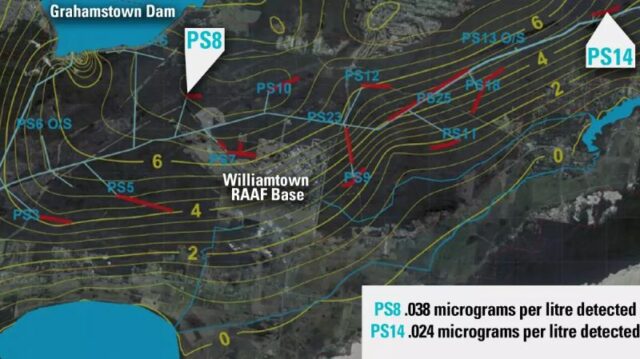2016 March: Williamtown (New South Wales) – PFAS

What’s happening to the water in Williamtown?
https://www.smh.com.au/lifestyle/whats-happening-to-the-water-in-williamtown-20160314-gniay1.html
“… In the case of Williamtown – a picture perfect expanse of small cattle and dairy farms, modest cottages on wide blocks, and saltmarsh dividing rich pasture from mangroves – its geology has helped spread the chemicals. The base sits on sandy soil above a shallow water table that rises after rain and draws down contaminants as it falls. Tasteless and odourless, PFCs have polluted bores of nearby properties and entered the Tomago sandbeds, a giant aquifer that provides about 20 per cent of the lower Hunter’s drinking water. Surface runoff has drained into Fullerton Cove, which is part of an internationally designated wetlands refuge for migratory shorebirds.
The Department of Defence and NSW Environment Protection Authority (EPA) have known for almost four years that noxious chemicals in fire-fighting foam were spreading out from the base – but only told the public last September. Community health was compromised while Defence and the EPA dallied and disagreed. Since the announcement, livelihoods have been lost and homes rendered worthless. Residents, fearful they may have been drinking poisoned bore water for years, refuse to use the official dispassionate term “investigation zone” to describe the contaminated area. They call it the “red zone”…
The line on the map marking the red zone has now been extended beyond its original boundary to encircle 430 households, as counted by the EPA. This group of households includes 165 families who drink bottled water supplied by the RAAF while they wait for town water connections to replace their condemned bores. Tainted water still escapes from the base and Defence admits it does not know how to stop it…
The RAAF knew as early as 2003 that PFOS and PFOA were suspected to cause cancer and may have spread to properties neighbouring Williamtown base. It took them a further eight years to act on the advice of their own experts to start testing for contamination. By 2012 the RAAF had proof the chemicals were washing out of the base in surface water. It informed the EPA, Hunter Water and Port Stephens Council but insisted on confidentiality.
Hunter Water, which supplies half a million people in the lower Hunter, embargoed three of its pumping stations to stop groundwater contamination reaching its bores. The state-owned company says it will seek compensation “in the order of tens of millions of dollars” for having to bring forward capital works to replace lost borelines….
A surface water test on King’s block showed a PFOS reading of 38.2 micrograms per litre – almost 200 times the 0.2 threshold level set by the US Environmental Protection Agency. “My sister and I used to play in drains and ponds around here,” she says. “I was pregnant with my youngest daughter [Madeline] when we built this house; I helped Colin dig the foundations. I lie in bed at night wondering, ‘What have I done to contaminate myself today? Did I expose my children to this poison?’ “
TOXIC SPREAD
Williamtown’s contamination has grabbed headlines but toxic fallout from fire-fighting foam used on military bases is a nationwide threat.
The Department of Defence is testing another 15 “priority” sites confirmed or likely to be PFC-contaminated across all states and the Northern Territory. A Senate committee of inquiry is due to report on the issue in April.
Queensland lawyers are already assembling a class action case on behalf of landowners hit by contamination from the Army Aviation Centre near the Darling Downs town of Oakey. Affected residents have recorded blood PFC levels of up to 44 times the national average.
Defence has confirmed PFC contamination at the RAAF’s Townsville base, which drains to the Great Barrier Reef, and at Richmond air force base north of Sydney which has caused fish kills in a creek running into the Hawkesbury River.
In Victoria, Defence has “prioritised” East Sale RAAF base for testing to begin this month.
Fire-fighting chemicals have contaminated Darwin RAAF base, which drains to a suburban creek, and Defence has predicted “significant levels” of contamination at RAAF Base Pearce, which is located next to the town of Bullsbrook north of Perth.
